Large-Scale and Deep-Seated Gravitational Slope Deformations on Mars: A Review
Abstract
1. Introduction
2. State of Art
2.1. Valles Marineris
2.2. Planum Australe
2.3. Acheron Dorsum
2.4. Noctis Labyrinthus
2.5. Martian Database
3. Discussion
3.1. Spatial Distribution
3.2. Morphological Characteristics
3.3. Control Factors
3.4. Trigger Factors
3.5. Landslides and Slope Collapses
4. Open Issues
5. Conclusions
Author Contributions
Funding
Institutional Review Board Statement
Informed Consent Statement
Data Availability Statement
Acknowledgments
Conflicts of Interest
References
- Sharp, R.P. Mars: Troughed terrain. J. Geophys. Res. 1973, 78, 4063–4072. [Google Scholar] [CrossRef]
- Lucchitta, B.K. Landslides in Valles Marineris, Mars. J. Geophys. Res. Solid Earth 1979, 84, 8097–8113. [Google Scholar] [CrossRef]
- McEwen, A.S. Mobility of large rock avalanches: Evidence from Valles Marineris. Mars. Geology 1989, 17, 1111–1114. [Google Scholar] [CrossRef]
- Shaller, R. Analysis and implications of large Martian and Terrestrial landslides. Ph.D. Thesis, California Institute of Technology, Pasadena, CA, USA, 1991. [Google Scholar]
- Lucchitta, B.K.; McEwen, A.S.; Clow, G.D.; Geissler, P.E.; Singer, R.B.; Schultz, R.A.; Squyres, S.W. The canyon system on Mars. In Mars; Kieffer, H.H., Jakosky, B.M., Snyder, C.W., Eds.; University of Arizona Press: Tucson, AZ, USA, 1992; pp. 453–492. [Google Scholar]
- Shaller, P.J.; Komatsu, G. Landslides on Mars. Landslides New 1994, 8, 18–22. [Google Scholar]
- Quantin, C.; Allemand, P.; Delacourt, C. Morphology and geometry of Valles Marineris landslides. Planet. Space Sci. 2004, 52, 1011–1022. [Google Scholar] [CrossRef]
- De Blasio, F.V. Landslides in Valles Marineris (Mars): A possible role of basal lubrication by sub-surface ice. Planet. Space Sci. 2011, 59, 1384–1392. [Google Scholar] [CrossRef]
- Lucas, A.; Mangeney, A.; Mége, D.; Bouchut, F. Influence of the scar geometry on landslide dynamics and deposits: Application to Martian landslides. J. Geophys. Res. Planets 2011, 116, E10001. [Google Scholar] [CrossRef]
- Brunetti, M.T.; Guzzetti, F.; Cardinali, M.; Fiorucci, F.; Santangelo, M.; Mancinelli, P.; Komatsu, G.; Borselli, L. Analysis of a new geomorphological inventory of landslides in Valles Marineris, Mars. Earth Planet. Sci. Lett. 2014, 405, 156–168. [Google Scholar] [CrossRef]
- Mazzanti, P.; De Blasio, F.V.; Di Bastiano, C.; Bozzano, F. Inferring the high velocity of landslides in Valles Marineris on Mars from morphological analysis. Earth Planets Space 2016, 68, 1–16. [Google Scholar] [CrossRef]
- Crosta, G.B.; Frattini, P.; Valbuzzi, E.; De Blasio, F.V. Introducing a new inventory of large Martian landslides. Earth Space Sci. 2018, 5, 89–119. [Google Scholar] [CrossRef]
- Crosta, G.B.; De Blasio, F.V.; Frattini, P. Global scale analysis of Martian landslide mobility and paleoenvironmental clues. J. Geophys. Res. Planets 2018, 123, 872–891. [Google Scholar] [CrossRef]
- Dramis, F.; Sorriso-Valvo, M. Deep-seated gravitational slope deformations, related landslides and tectonics. Eng. Geol. 1994, 38, 231–243. [Google Scholar] [CrossRef]
- Agliardi, F.; Crosta, G.B.; Frattini, P. Slow rock-slope deformation. In Landslides: Types, Mechanisms and Modeling; Clague, J.J., Stead, D., Eds.; Cambridge University Press: Cambridge, UK, 2012; pp. 207–221. [Google Scholar]
- Varnes, D.J.; Radbruch-Hall, D.H.; Varnes, K.L.; Smith, W.K.; Savage, W.Z. Measurement of ridge-spreading movements (Sackungen) at Bald Eagle Mountain, Lake County, Colorado, 1975–1989. In USGS Numbered Series; Open File Report; US Geological Survey: Denver, CO, USA, 1990; 13p. [Google Scholar]
- Agliardi, F.; Crosta, G.B.; Zanchi, A. Structural constraints on deep-seated slope deformation kinematics. Eng. Geol. 2001, 59, 83–102. [Google Scholar] [CrossRef]
- Ambrosi, C.; Crosta, G.B. Large sackung along major tectonic features in the Central Italian Alps. Eng. Geol. 2006, 83, 183–200. [Google Scholar] [CrossRef]
- Jaboyedoff, M.; Penna, I.; Pedrazzini, A.; Baroň, I.; Crosta, G.B. An introductory review on gravitational-deformation induced structures, fabrics and modeling. Tectonophysics 2013, 605, 1–12. [Google Scholar] [CrossRef]
- Pánek, T.; Klimeš, J. Temporal behavior of deep-seated gravitational slope deformations: A review. Earth Sci. Rev. 2016, 156, 14–38. [Google Scholar] [CrossRef]
- Della Seta, M.; Esposito, C.; Marmoni, G.M.; Martino, S.; Scarascia Mugnozza, G.; Troiani, F. Morpho-structural evolution of the valley-slope systems and related implications on slope-scale gravitational processes: New results from the Mt. Genzana case history (Central Apennines, Italy). Geomorphology 2017, 289, 60–77. [Google Scholar] [CrossRef]
- Radbruch-Hall, D.H. Gravitational creep of rock masses slopes. In Rockslides and Avalanches Natural Phenomena; Development in Geotechnical Engineering; Voight, B., Ed.; Elsevier: Amsterdam, The Netherlands, 1978; pp. 607–657. [Google Scholar]
- Bovis, M.J. Uphill-facing (antislope) scarps in the Coast Mountains, southwest British Columbia. Bull. Geol. Soc. Am. 1982, 93, 804–812. [Google Scholar] [CrossRef]
- Savage, W.Z.; Varnes, D.J. Mechanics of gravitational spreading of steep-sided ridges («sackung»). Bull. Int. Assoc. Eng. Geol. 1987, 35, 31–36. [Google Scholar] [CrossRef]
- Esposito, C.; Di Luzio, E.; Scarascia Mugnozza, G.; Bianchi Fasani, G. Mutual interactions between slope-scale gravitational processes and morpho-structural evolution of central Apennines (Italy): Review of some selected case histories. Rend. Linc. 2014, 25, 151–165. [Google Scholar] [CrossRef]
- Crosta, G.B.; Frattini, P.; Agliardi, F. Deep seated gravitational slope deformations in the European Alps. Tectonophysics 2013, 605, 13–33. [Google Scholar] [CrossRef]
- Jarman, D.; Harrison, S. Rock slope failure in the British mountains. Geomorphology 2019, 340, 202–233. [Google Scholar] [CrossRef]
- Esposito, C.; Martino, S.; Scarascia Mugnozza, G. Mountain slope deformations along thrust fronts in jointed limestone: An equivalent continuum modelling approach. Geomorphology 2007, 90, 55–72. [Google Scholar] [CrossRef]
- Discenza, M.E.; Esposito, C.; Martino, S.; Petitta, M.; Prestininzi, A.; Scarascia Mugnozza, G. The gravitational slope deformation of Mt. Rocchetta ridge (central Apennines, Italy): Geological-evolutionary model and numerical analysis. Bull. Eng. Geol. Environ. 2011, 70, 559–575. [Google Scholar] [CrossRef]
- Martino, S.; Della Seta, M.; Esposito, C. Back-analysis of rock landslides to infer rheological parameters. In Rock Mechanics and Engineering, Analysis, Modeling and Design; Feng, X.T., Ed.; Taylor and Francis: London, UK, 2017; Volume 3, pp. 237–268. [Google Scholar]
- Bonzanigo, L.; Eberhardt, E.; Loew, S. Long-term investigation of a deep-seated creeping landslide in crystalline rock. Part I. Geological and hydromechanical factors controlling the Campo Vallemaggia landslide. Can. Geotech. J. 2007, 44, 1157–1180. [Google Scholar] [CrossRef]
- Madritsch, H.; Millen, B.M.J. Hydrogeologic evidence for a continuous basal shear zone within a deep-seated gravitational slope deformation (Eastern Alps, Tyrol, Austria). Landslides 2007, 4, 149–162. [Google Scholar] [CrossRef]
- Barla, G.; Antolini, F.; Barla, M.; Mensi, E.; Piovano, G. Monitoring of the Beauregard landslide (Aosta Valley, Italy) using advanced and conventional techniques. Eng. Geol. 2010, 116, 218–235. [Google Scholar] [CrossRef]
- Strauhal, T.; Zangerl, C.; Fellin, W.; Holzmann, M.; Engl, D.A.; Brandner, R.; Tropper, P.; Tessadri, R. Structure, mineralogy and geomechanical properties of shear zones of deep-seated rockslides in metamorphic rocks (Tyrol, Austria). Rock Mech. Rock Eng. 2017, 50, 419–438. [Google Scholar] [CrossRef]
- Vick, L.M.; Böhme, M.; Rouyet, L.; Bergh, S.G.; Corner, G.D.; Lauknes, T.R. Structurally controlled rock slope deformation in northern Norway. Landslides 2020, 17, 1745–1746. [Google Scholar] [CrossRef]
- Ter-Stepanian, G. Types of depth creep of slopes in rock masses. Probl. Geomech. 1966, 3, 49–69. [Google Scholar]
- Nemčok, A. Gravitational slope deformation in high mountains. In Proceedings of the 24th International Geological Congress, Montreal, QC, Canada, 21–30 August 1972; Section 13. pp. 132–141. [Google Scholar]
- Mahr, T.; Nemčok, A. Deep-seated creep deformations in the crystalline cores of the Tatry Mts. Bull. Int. Assoc. Eng. Geol. 1977, 16, 104–106. [Google Scholar] [CrossRef]
- Chigira, M. Long-term gravitational deformation of rocks by mass rock creep. Eng. Geol. 1992, 32, 157–184. [Google Scholar] [CrossRef]
- Martino, S.; Prestininzi, A.; Scarascia Mugnozza, G. Geological-evolutionary model of a gravity-induced slope deformation in the carbonate Central Apennines (Italy). Q. J. Eng. Geol. Hydrogeol. 2004, 37, 31–47. [Google Scholar] [CrossRef]
- Apuani, T.; Masetti, M.; Rossi, M. Stress-strain-time numerical modelling of a deep-seated gravitational slope deformation: Preliminary results. Quat. Int. 2007, 171–172, 80–89. [Google Scholar] [CrossRef]
- Bozzano, F.; Martino, S.; Montagna, A.; Prestininzi, A. Back analysis of a rock landslide to infer rheological parameters. Eng. Geol. 2012, 131, 45–56. [Google Scholar] [CrossRef]
- Bozzano, F.; Della Seta, M.; Martino, S. Time-dependent evolution of rock slopes by a multi-modelling approach. Geomorphology 2016, 263, 113–131. [Google Scholar] [CrossRef]
- Zischinsky, U. On the deformation of high slopes. In Proceedings of the 1st Conference of the International Society of Rock Mechanics, Lisbon, Portugal, 25 September–1 October 1966; Volume 2, pp. 179–185. [Google Scholar]
- Mahr, T. Deep-reaching gravitational deformations of high mountain slopes. Bull. Int. Assoc. Eng. Geol. 1977, 16, 121–127. [Google Scholar] [CrossRef]
- Hutchinson, J.N. General report: Morphological and geotechnical parameters of landslides in relation to geology and hydrogeology. In Proceedings of the 5th International Symposium on Landslides, Lausanne, Switzerland, 10–15 July 1988; Volume 1, pp. 3–35. [Google Scholar] [CrossRef]
- Bianchi Fasani, G.; Esposito, C.; Maffei, A.; Scarascia Mugnozza, G.; Evans, S.G. Geological controls on initial failure mechanisms of rock avalanches in central Apennines (Italy). In Proceedings of the 9th International Symposium on Landslides, Rio de Janeiro, Brazil, 28 June–2 July 2004; Lacerda, E., Fontoura, S., Eds.; pp. 501–507. [Google Scholar]
- Ambrosi, C.; Crosta, G.B. Valley shape influence on deformation mechanisms of rock slopes. Geol. Soc. Spec. Publ. 2011, 351, 215–233. [Google Scholar] [CrossRef]
- Jaboyedoff, M.; Couture, R.; Locat, P. Structural analysis of Turtle Mountain (Alberta) using digital elevation model: Toward a progressive failure. Geomorphology 2009, 103, 5–16. [Google Scholar] [CrossRef]
- El Bedoui, S.; Bois, T.; Jomard, H.; Sanchez, G.; Lebourg, T.; Trics, E.; Guglielmi, Y.; Bouissou, S.; Chemenda, A.; Rolland, Y.; et al. Paraglacial gravitational deformations in the SW Alps: A review of field investigations, 10Be cosmogenic dating and physical modelling. Geol. Soc. Spec. Publ. 2011, 351, 11–25. [Google Scholar] [CrossRef]
- Discenza, M.E.; Martino, S.; Bretschneider, A.; Scarascia Mugnozza, G. Influence of joints on creep processes involving rock masses: Results from physical-analogue laboratory tests. Int. J. Rock Mech. Min. Sci. 2020, 128, 104261. [Google Scholar] [CrossRef]
- Hungr, O.; Evans, S.G. Entrainment of debris in rock avalanches: An analysis of a long run-out mechanism. Bull. Geol. Soc. Am. 2004, 116, 1240–1252. [Google Scholar] [CrossRef]
- Evans, S.G.; Scarascia Mugnozza, G.; Strom, A.L.; Hermanns, R.L.; Ischuk, A.; Vinnichenko, S. Landslides from massive rock slope failure and associated phenomena. In Landslides from Massive Rock Slope Failure; Evans, S.G., Scarascia Mugnozza, G., Strom, A.L., Hermanns, R.L., Eds.; Springer: Dordrecht, The Netherlands, 2006; pp. 3–52. [Google Scholar] [CrossRef]
- Chigira, M.; Wu, X.; Inokuchi, T.; Wang, G. Landslides induced by the 2008 Wenchuan earthquake, Sichuan, China. Geomorphology 2010, 118, 225–238. [Google Scholar] [CrossRef]
- Blasius, K.R.; Cutts, J.A.; Guest, J.E.; Masursky, H. Geology of the Valles Marineris: First analysis of imaging from the Viking 1 Orbiter Primary Mission. J. Geophys. Res. 1977, 82, 4067–4091. [Google Scholar] [CrossRef]
- Christiansen, E.H.; Head, J.W. Martian landslides classification and genesis: Reports of Planetary Geology Programs. Rep. Planet. Geol. Prog. 1978, 79729, 285–287. [Google Scholar]
- Lucchitta, B.K. A large landslide on Mars. Bull. Geol. Soc. Am. 1978, 89, 1601–1609. [Google Scholar] [CrossRef]
- Peulvast, J.P.; Mège, D.; Chiciak, J.; Costard, F.; Masson, P.L. Morphology, evolution and tectonics of Valles Marineris wallslopes (Mars). Geomorphology 2001, 37, 329–352. [Google Scholar] [CrossRef]
- Bulmer, M.H.; Zimmerman, B.A. Reassessing landslide deformation in Ganges Chasma, Mars. Geophys. Res. Lett. 2005, 32, L06201. [Google Scholar] [CrossRef]
- Mège, D.; Bourgeois, O. Equatorial glaciations on Mars revealed by gravitational collapse of Valles Marineris wallslopes. Earth Planet. Sci. Lett. 2011, 310, 182–191. [Google Scholar] [CrossRef]
- Gourronc, M.; Bourgeois, O.; Mège, D.; Pochat, S.; Bultel, B.; Massé, M.; Le Deit, L.; Le Mouélic, S.; Mercier, D. One million cubic kilometers of fossil ice in Valles Marineris: Relicts of a 3.5 Gy old glacial landsystem along the Martian equator. Geomorphology 2014, 204, 235–255. [Google Scholar] [CrossRef]
- Makowska, M.; Gueydan, F.; Mège, D. Mechanical approach on Deep-seated Gravitational Spreading in Coprates Chasma, Valles Marineris, Mars. In Proceedings of the European Planetary Science Congress, Cascais, Portugal, 7–12 September 2014; Volume 9. EPSC2014-334. [Google Scholar]
- Makowska, M.; Mège, D.; Gueydan, F.; Chéry, J. Mechanical conditions and modes of paraglacial deep-seated gravitational spreading in Valles Marineris, Mars. Geomorphology 2016, 268, 246–252. [Google Scholar] [CrossRef]
- Kromuszczyńska, O.; Makowska, M.; Dębniak, K. Valles Marineris: A place full of answers. In Insights on Environmental Changes. GeoPlanet: Earth and Planetary Sciences; Zielinski, T., Pazdro, K., Dragan-Górska, A., Weydmann, A., Eds.; Springer: Cham, Switzerland, 2014; pp. 17–32. [Google Scholar] [CrossRef]
- Kromuszczyńska, O.; Dębniak, K. Comparison of Martian and Terrestrial DSGSD scarps. In Proceedings of the 47th Lunar and Planetary Science Conference, The Woodlands, TX, USA, 21–25 March 2016. 1902. [Google Scholar]
- Kromuszczyńska, O.; Mège, D.; Dębniak, K.; Gurgurewicz, J.; Makowska, M.; Lucas, A. Deep-seated gravitational slope deformation scaling on Mars and Earth: Same fate for different initial conditions and structural evolutions. Earth Surf. Dyn. 2019, 7, 361–376. [Google Scholar] [CrossRef]
- Guallini, L.; Brozzetti, F.; Marinangeli, L. First evidence of incipient large-scale gravitational tectonic collapse in South Polar Layered Deposits? The case of Promethei Lingula (Mars). In Proceedings of the 42nd Lunar and Planetary Science Conference, The Woodlands, TX, USA, 7–11 March 2011. 1678. [Google Scholar]
- Guallini, L.; Brozzetti, F.; Marinangeli, L. Large-scale deformational systems in the South Polar Layered Deposits (Promethei Lingula, Mars): “soft-sediment” and deep-seated gravitational slope deformations mechanisms. Icarus 2012, 220, 821–843. [Google Scholar] [CrossRef]
- Guallini, L.; Pauselli, C.; Brozzetti, F.; Marinangeli, L. Physical modelling of large-scale deformational systems in the South Polar Layered Deposits (Promethei Lingula, Mars): New geological constraints and climatic implications. Geol. Soc. Spec. Publ. 2015, 401, 405–421. [Google Scholar] [CrossRef]
- De Blasio, F.V.; Martino, S. The Acheron Dorsum on Mars: A novel interpretation of its linear depressions and a model for its evolution. Earth Planet. Sci. Lett. 2017, 465, 92–102. [Google Scholar] [CrossRef]
- Cremonese, G.; Simioni, E.; Re, C.; Mudrič, T.; Lucchetti, A.; Massironi, M.; Pommerol, A.; Roloff, V.A.; Thomas, N.; Tornabene, L. First Mars Surface Stereo Reconstruction with the CaSSIS Stereo Camera. In Proceedings of the 48th Lunar and Planetary Science Conference, The Woodlands, TX, USA, 20–24 March 2017. 1464. [Google Scholar]
- Massironi, M.; Pozzobon, R.; Lucchetti, A.; Simioni, E.; Re, C.; Mudrič, T.; Pajola, M.; Cremonese, G.; Pommerol, A.; Salese, F.; et al. A three-dimensional geological reconstruction of Noctis Labyrinthus slope tectonics from CaSSIS data. In Proceedings of the European Planetary Science Congress, Riga, Latvia, 17–22 September 2017; Volume 11. EPSC2017-618-1. [Google Scholar]
- Zischinsky, U. Über Sackungen. Rock Mech. 1969, 1, 30–52. [Google Scholar] [CrossRef]
- Radbruch-Hall, D.H.; Varnes, D.J.; Savage, W.Z. Gravitational spreading of steep-sided ridges (“sackung”) in Western United States. Bull. Int. Assoc. Eng. Geol. 1976, 13, 23–35. [Google Scholar] [CrossRef]
- Hermann, S.W.; Madritsch, G.; Rauth, H.; Becker, L.P. Modes and structural conditions of large scale mass movements (Sackungen) on crystalline basement units of the Eastern Alps (Niedere Tauern, Austria). Mitt. Naturwiss Ver. Steiermark 2000, 130, 31–42. [Google Scholar]
- Hippolyte, J.C.; Brocard, G.; Tardy, M.; Nicoud, G.; Bourles, D.; Braucher, R.; Ménard, G.; Souffaché, B. The recent fault scarps of the Western Alps (France): Tectonic surface ruptures or gravitational sackung scarps? A combined mapping, geomorphic, levelling, and 10Be dating approach. Tectonophysics 2006, 418, 255–276. [Google Scholar] [CrossRef]
- Hürlimann, M.; Ledesma, A.; Corominas, J.; Prat, P.C. The deep-seated slope deformation at Encampadana, Andorra: Representation of morphologic features by numerical modelling. Eng. Geol. 2006, 83, 343–357. [Google Scholar] [CrossRef]
- Brideau, M.A.; Yan, M.; Stead, D. The role of tectonic damage and brittle rock fracture in the development of large rock slope failures. Geomorphology 2009, 103, 30–49. [Google Scholar] [CrossRef]
- Reitner, J.M.; Linner, M. Formation and preservation of large scale toppling related to alpine tectonic structures—Eastern Alps. Austrian J. Earth Sci. 2009, 102, 69–80. [Google Scholar]
- Stead, D.; Wolter, A. A critical review of rock slope failure mechanisms: The importance of structural geology. J. Struct. Geol. 2015, 74, 1–23. [Google Scholar] [CrossRef]
- Alfaro, P.; Delgado, J.; Esposito, C.; Tortosa, G.F.; Marmoni, G.M.; Martino, S. Time-dependent modelling of a mountain front retreat due to a fold-to-fault controlled lateral spreading. Tectonophysics 2019, 773, 228233. [Google Scholar] [CrossRef]
- Pánek, T.; Hradecký, J.; Šilhán, K.; Smolková, V.; Altová, V. Time constraints for the evolution of a large slope collapse in karstified mountainous terrain of the southwestern Crimean Mountains, Ukraine. Geomorphology 2009, 108, 171–181. [Google Scholar] [CrossRef]
- Lenti, L.; Martino, S.; Paciello, A.; Prestininzi, A.; Rivellino, S. Microseismicity within a karstified rock mass due to cracks and collapses as a tool for risk management. Nat. Hazards 2012, 64, 359–379. [Google Scholar] [CrossRef][Green Version]
- Gutiérrez, F.; Carbonel, D.; Guerrero, J.; McCalpin, J.P.; Linares, R.; Roqué, C.; Zarroca, M. Late Holocene episodic displacement on fault scarps related to interstratal dissolution of evaporites (Teruel Neogene Graben, NE Spain). J. Struct. Geol. 2012, 34, 2–19. [Google Scholar] [CrossRef]
- Carbonel, D.; Gutiérrez, F.; Linares, R.; Roqué, C.; Zarroca, M.; McCalpin, J.; Guerrero, J.; Rodríguez, V. Differentiating between gravitational and tectonic faults by means of geomorphological mapping, trenching and geophysical surveys. The case of the Zenzano Fault (Iberian Chain, N Spain). Geomorphology 2013, 189, 93–108. [Google Scholar] [CrossRef]
- Agliardi, F.; Crosta, G.B.; Zanchi, A.; Ravazzi, C. Onset and timing of deep-seated gravitational slope deformations in the eastern Alps, Italy. Geomorphology 2009, 103, 113–129. [Google Scholar] [CrossRef]
- Varnes, D.J.; Radbruch-Hall, D.H.; Savage, W.Z. Topographic and structural conditions in areas of gravitational spreading of ridges in the Western United States. US Geol. Surv. Prof. Pap. 1989, 1496, 1–27. [Google Scholar] [CrossRef]
- Hou, Y.L.; Chigira, M.; Tsou, C.Y. Numerical study on deep-seated gravitational slope deformation in a shale-dominated dip slope due to river incision. Eng. Geol. 2014, 179, 59–75. [Google Scholar] [CrossRef]
- Jibson, R.W.; Harp, E.L.; Schulz, W.; Keefer, D.K. Landslides triggered by the 2002 Denali fault, Alaska, earthquake and the inferred nature of the strong shaking. Earthq. Spectra 2004, 20, 669–691. [Google Scholar] [CrossRef]
- Moro, M.; Saroli, M.; Salvi, S.; Stramondo, S.; Doumaz, F. The relationship between seismic deformation and deep-seated gravitational movements during the 1997 Umbria-Marche (Central Italy) earthquakes. Geomorphology 2007, 89, 297–307. [Google Scholar] [CrossRef]
- Amato, G.; Devoti, R.; Fubelli, G.; Aringoli, D.; Bignami, C.; Galvani, A.; Moro, M.; Polcari, M.; Saroli, M.; Sepe, V.; et al. Step-like displacements of a deep seated gravitational slope deformation observed during the 2016–2017 seismic events in Central Italy. Eng. Geol. 2018, 246, 337–348. [Google Scholar] [CrossRef]
- Agliardi, F.; Riva, F.; Barbarano, M.; Zanchetta, S.; Scotti, R.; Zanchi, A. Effects of tectonic structures and long-term seismicity on paraglacial giant slope deformations: Piz Dora (Switzerland). Eng. Geol. 2019, 263, 105353. [Google Scholar] [CrossRef]
- Bovis, M.J. Rock-slope deformation at Affliction Creek, southern Coast Mountains, British Columbia. Can. J. Earth Sci. 1990, 27, 243–254. [Google Scholar] [CrossRef]
- McCalpin, J.P.; Irvine, J.R. Sackungen at the Aspen Highlands Ski Area, Pitkin County, Colorado. Environ. Eng. Geosci. 1995, 1, 277–290. [Google Scholar] [CrossRef]
- Bovis, M.J.; Stewart, T.W. Long-term deformation of a glacially undercut rock slope, southwest British Columbia. In Proceedings of the 8th International Congress, International Association for Engineering Geology and the Environment, Vancouver, BC, Canada, 21–25 September 1998; pp. 1267–1276. [Google Scholar]
- Ballantyne, C.K. Paraglacial geomorphology. Quat. Sci. Rev. 2002, 21, 1935–2017. [Google Scholar] [CrossRef]
- Jarman, D. Large rock slope failures in the Highlands of Scotland: Characterisation, causes and spatial distribution. Eng. Geol. 2006, 83, 161–182. [Google Scholar] [CrossRef]
- Hippolyte, J.C.; Bourlès, D.; Braucher, R.; Carcaillet, J.; Léanni, L.; Arnold, M.; Aumaitre, G. Cosmogenic 10Be dating of a sackung and its faulted rock glaciers, in the Alps of Savoy (France). Geomorphology 2009, 108, 312–320. [Google Scholar] [CrossRef]
- McColl, S.T.; Davies, T.R.H.; McSaveney, M.J. Glacier retreat and rock-slope stability: Debunking debuttressing. In Geologically Active; Williams, A.L., Pinches, G.M., Chin, C.Y., McMorran, T.J., Massey, C.I., Eds.; Taylor and Francis: London, UK, 2010; pp. 467–474. [Google Scholar]
- McColl, S.T. Paraglacial rock-slope stability. Geomorphology 2012, 153, 1–16. [Google Scholar] [CrossRef]
- Baroni, C.; Martino, S.; Salvatore, M.C.; Scarascia Mugnozza, G.; Schilirò, L. Thermomechanical stress-strain numerical modelling of deglaciation since the Last Glacial Maximum in the Adamello Group (Rhaetian Alps, Italy). Geomorphology 2014, 226, 278–299. [Google Scholar] [CrossRef]
- Leith, K.; Moore, J.R.; Amann, F.; Loew, S. Subglacial extensional fracture development and implications for Alpine Valley evolution. J. Geophys. Res. Earth Surf. 2014, 119, 62–81. [Google Scholar] [CrossRef]
- Kissick, L.E.; Carbonneau, P.E. The case against vast glaciation in Valles Marineris, Mars. Icarus 2019, 321, 803–823. [Google Scholar] [CrossRef]
- Nicoletti, P.G.; Parise, M.; Miccadei, E. The Scanno rock avalanche (Abruzzi, south-central Italy). Boll. Soc. Geol. It. 1993, 112, 523–535. [Google Scholar]
- Hewitt, K. Rock avalanches with complex run out and emplacement, Karakoram Himalaya, Inner Asia. In Landslides from Massive Rock Slope Failure; Evans, S.G., Scarascia Mugnozza, G., Strom, A.L., Hermanns, R.L., Eds.; Springer: Dordrecht, The Netherlands, 2006; pp. 521–550. [Google Scholar] [CrossRef]
- Pánek, T.; Hradecký, J.; Minár, J.; Hungr, O.; Dušek, R. Late Holocene catastrophic slope collapse affected by deep-seated gravitational deformation in flysch: Ropice Mountain, Czech Republic. Geomorphology 2009, 103, 414–419. [Google Scholar] [CrossRef]
- Böhme, M.; Hermanns, R.L.; Oppikofer, T.; Fischer, L.; Bunkholt, H.S.S.; Eiken, T.; Pedrazzini, A.; Derron, M.H.; Jaboyedoff, M.; Blikra, L.H.; et al. Analyzing complex rock slope deformation at Stampa, western Norway, by integrating geomorphology, kinematics and numerical modeling. Eng. Geol. 2013, 154, 116–130. [Google Scholar] [CrossRef]
- Pedrazzini, A.; Jaboyedoff, M.; Loye, A.; Derron, M.H. From deep seated slope deformation to rock avalanche: Destabilization and transportation models of the Sierre landslide (Switzerland). Tectonophysics 2013, 605, 149–168. [Google Scholar] [CrossRef]
- Bianchi Fasani, G.; Di Luzio, E.; Esposito, C.; Evans, S.G.; Scarascia Mugnozza, G. Quaternary, catastrophic rock avalanches in the Central Apennines (Italy): Relationships with inherited tectonic features, gravity-driven deformations and the geodynamic frame. Geomorphology 2014, 211, 22–42. [Google Scholar] [CrossRef]
- Del Ventisette, C.; Gigli, G.; Bonini, M.; Corti, G.; Montanari, D.; Santoro, S.; Sani, F.; Fanti, R.; Casagli, N. Insights from analogue modelling into the deformation mechanism of the Vaiont landslide. Geomorphology 2015, 228, 52–59. [Google Scholar] [CrossRef]
- Bentivenga, M.; Giano, S.I.; Murgante, B.; Nolè, G.; Palladino, G.; Prosser, G.; Saganeiti, L.; Tucci, B. Application of field surveys and multitemporal in-SAR interferometry analysis in the recognition of deep-seated gravitational slope deformation of an urban area of Southern Italy. Geomat. Nat. Haz. Risk 2019, 10, 1327–1345. [Google Scholar] [CrossRef]
- Delchiaro, M.; Della Seta, M.; Martino, S.; Dehbozorgi, M.; Nozaem, R. Reconstruction of river valley evolution before and after the emplacement of the giant Seymareh rock avalanche (Zagros Mts., Iran). Earth Surf. Dyn. 2019, 7, 929–947. [Google Scholar] [CrossRef]
- Neuffer, D.P.; Schultz, R.A. Mechanisms of slope failure in Valles Marineris, Mars. Q. J. Eng. Geol. Hydrogeol. 2006, 39, 227–240. [Google Scholar] [CrossRef]
- Kumar, P.S.; Krishna, N.; Lakshmi, K.P.J.; Raghukanth, S.T.G.; Dhabu, A.; Platz, T. Recent seismicity in Valles Marineris, Mars: Insights from young faults, landslides, boulder falls and possible mud volcanoes. Earth Planet. Sci. Lett. 2019, 505, 51–64. [Google Scholar] [CrossRef]
- Chigira, M.; Kiho, K. Deep-seated rockslide-avalanches preceded by mass rock creep of sedimentary rocks in the Akaishi Mountains, central Japan. Eng. Geol. 1994, 38, 221–230. [Google Scholar] [CrossRef]
- Wilson, A.J.; Petley, D.N.; Murphy, W. Down-slope variation in geotechnical parameters and pore fluid control on a large-scale Alpine landslide. Geomorphology 2003, 54, 49–62. [Google Scholar] [CrossRef]
- Crosta, G.B.; Di Prisco, C.; Frattini, P.; Frigerio, G.; Castellanza, R.; Agliardi, F. Chasing a complete understanding of the triggering mechanisms of a large rapidly evolving rockslide. Landslides 2014, 11, 747–764. [Google Scholar] [CrossRef]
- Francioni, M.; Calamita, F.; Coggan, J.; De Nardis, A.; Eyre, M.; Miccadei, E.; Piacentini, T.; Stead, D.; Sciarra, N. A multi-disciplinary approach to the study of large rock avalanches combining remote sensing, GIS and field surveys: The case of the Scanno landslide, Italy. Remote Sens. 2019, 11, 1570. [Google Scholar] [CrossRef]
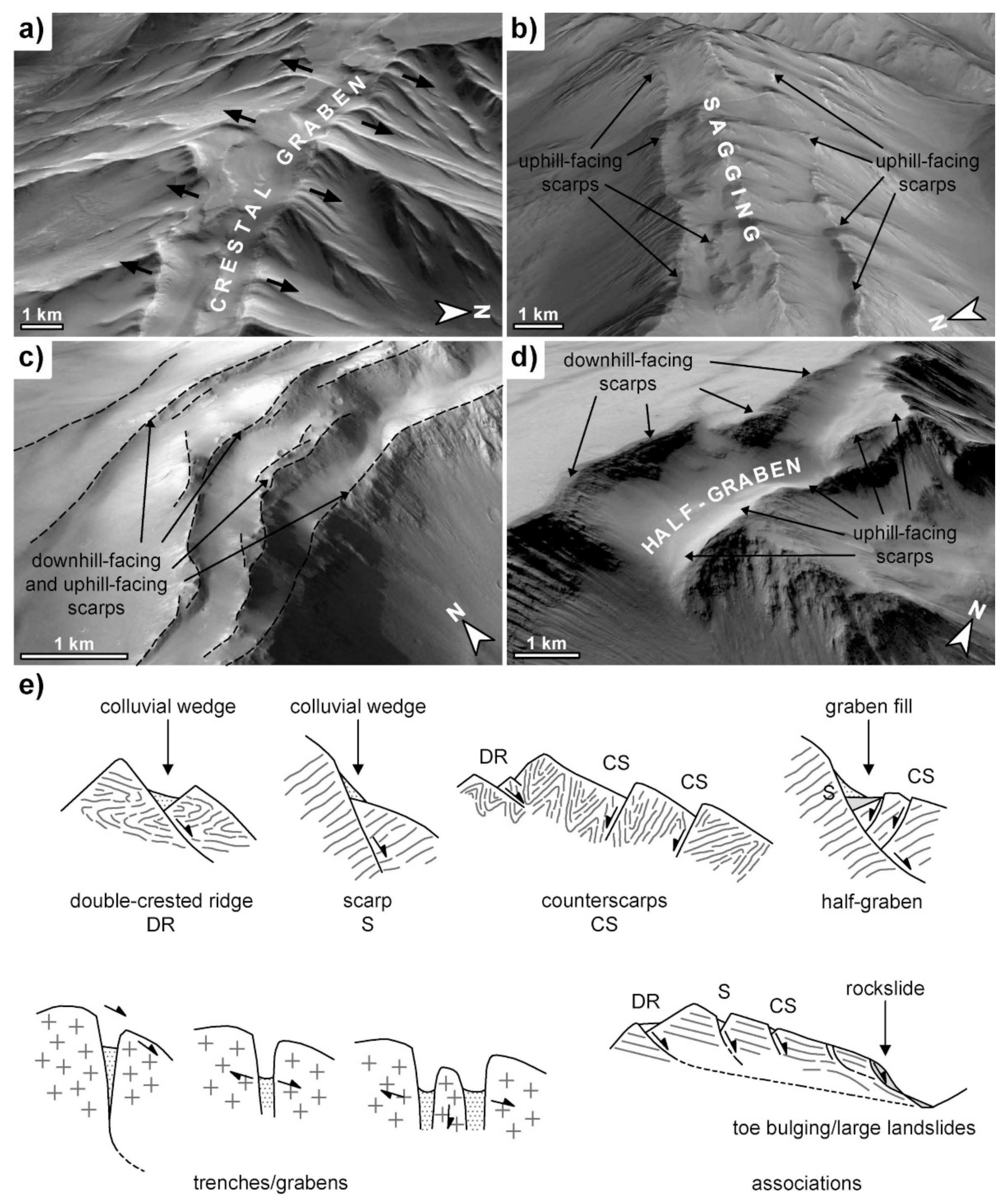
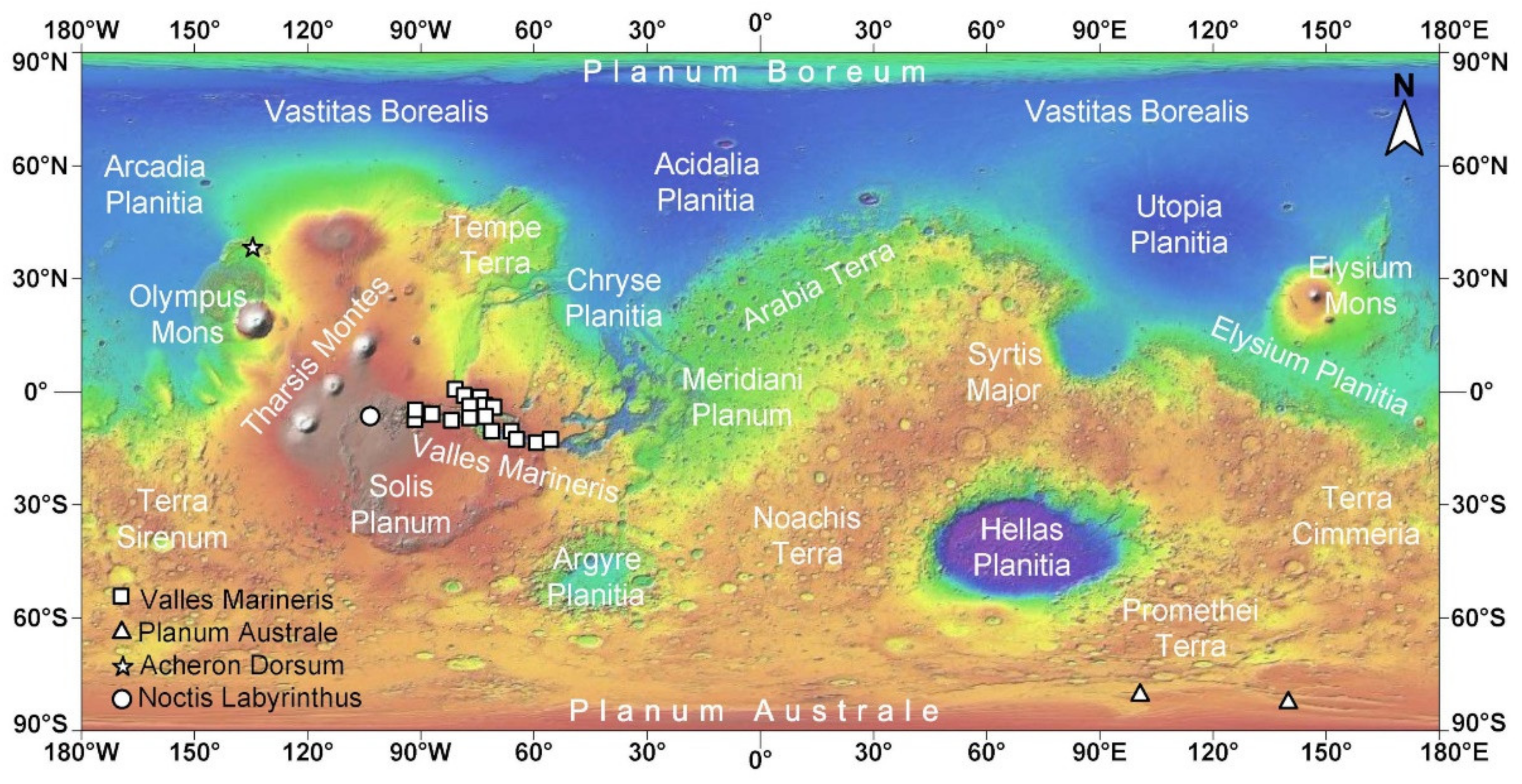
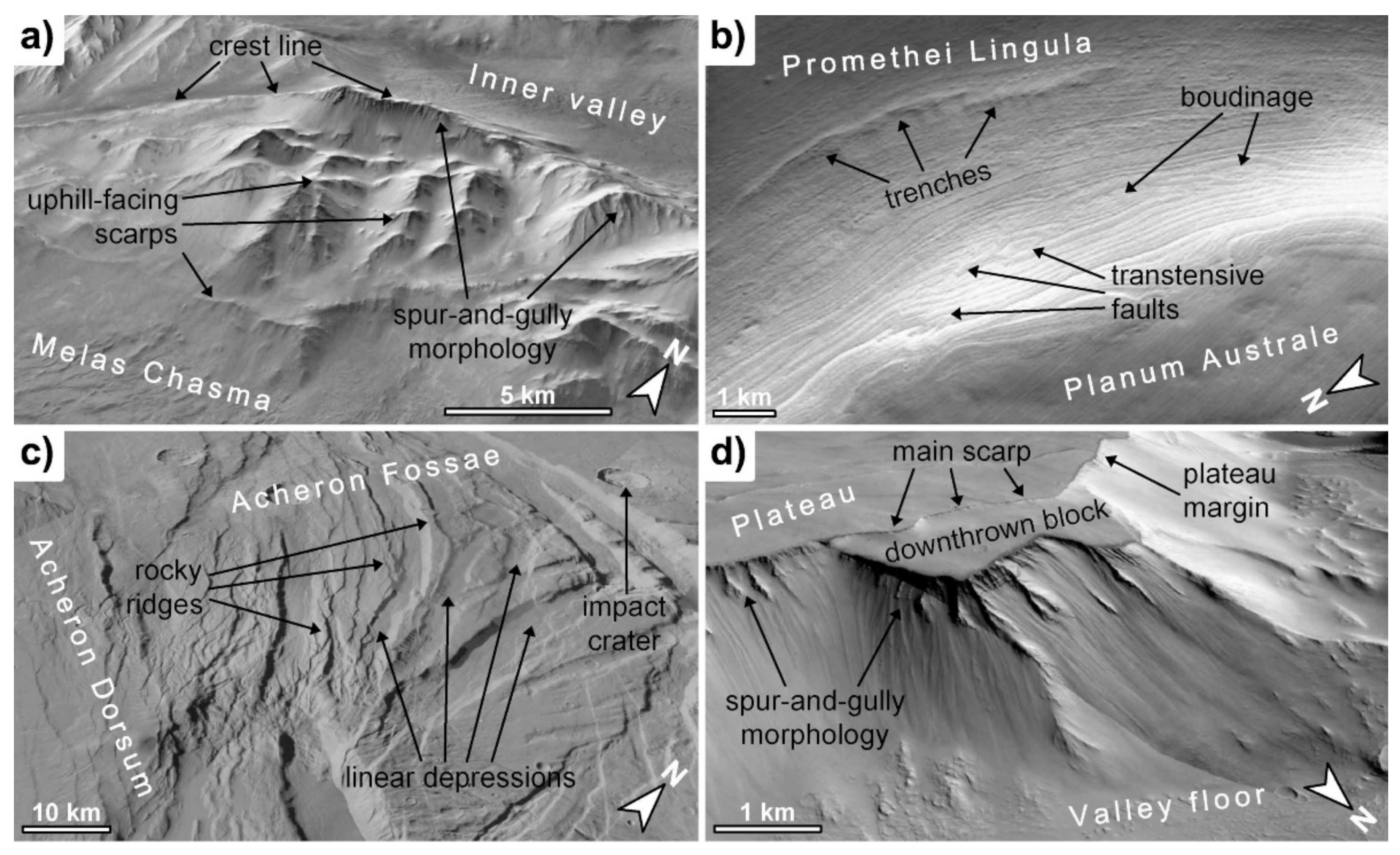

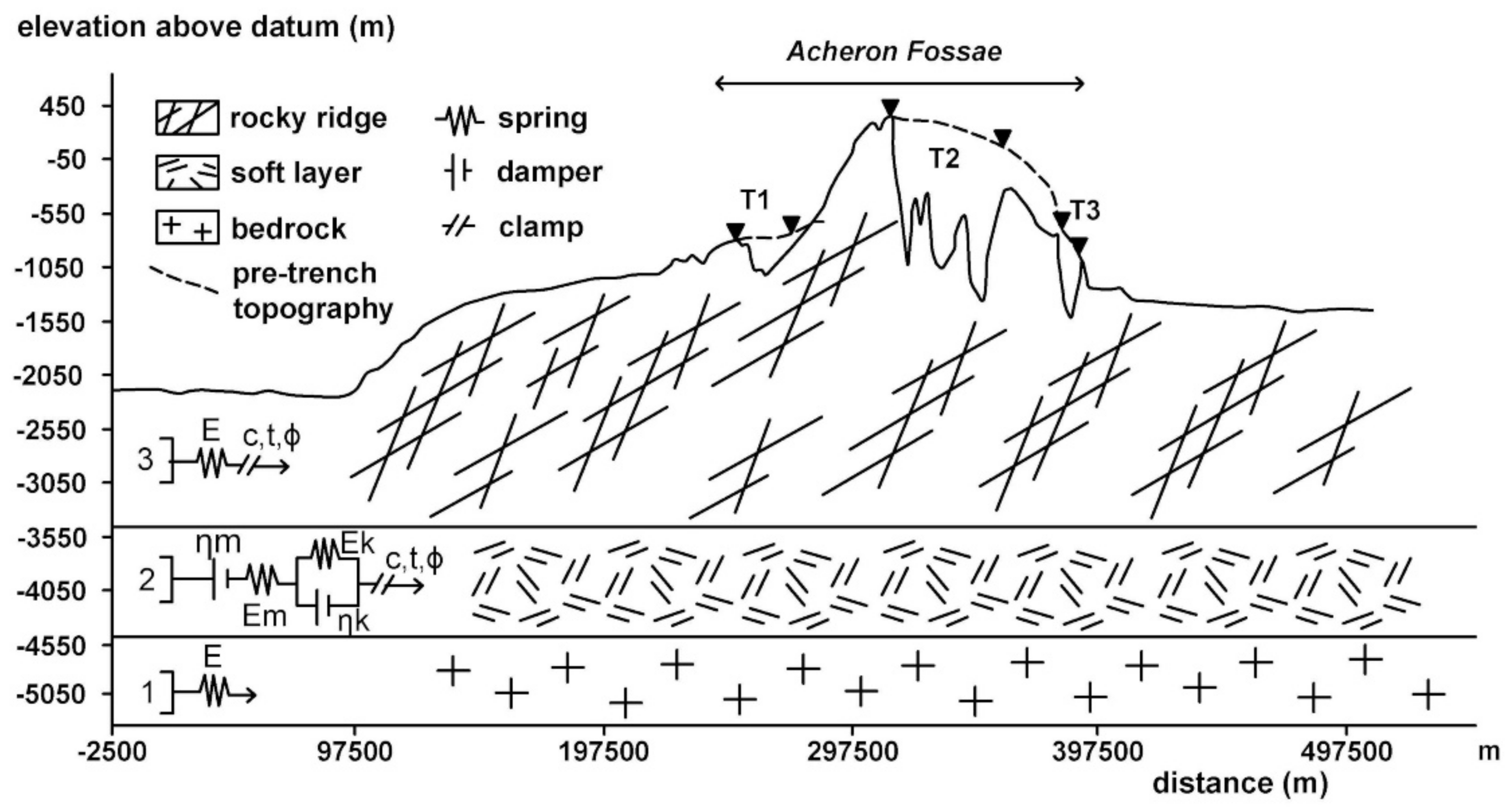



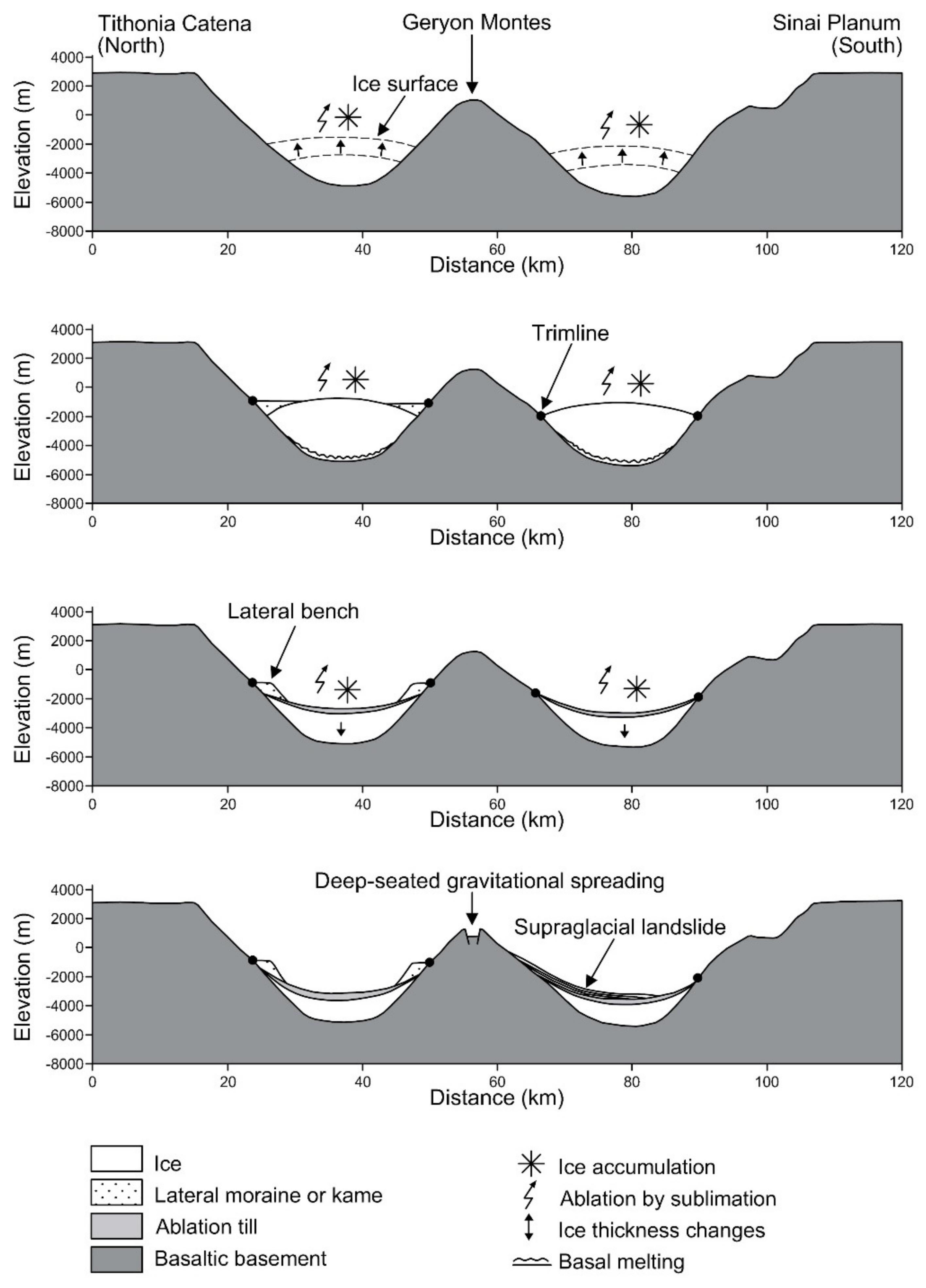
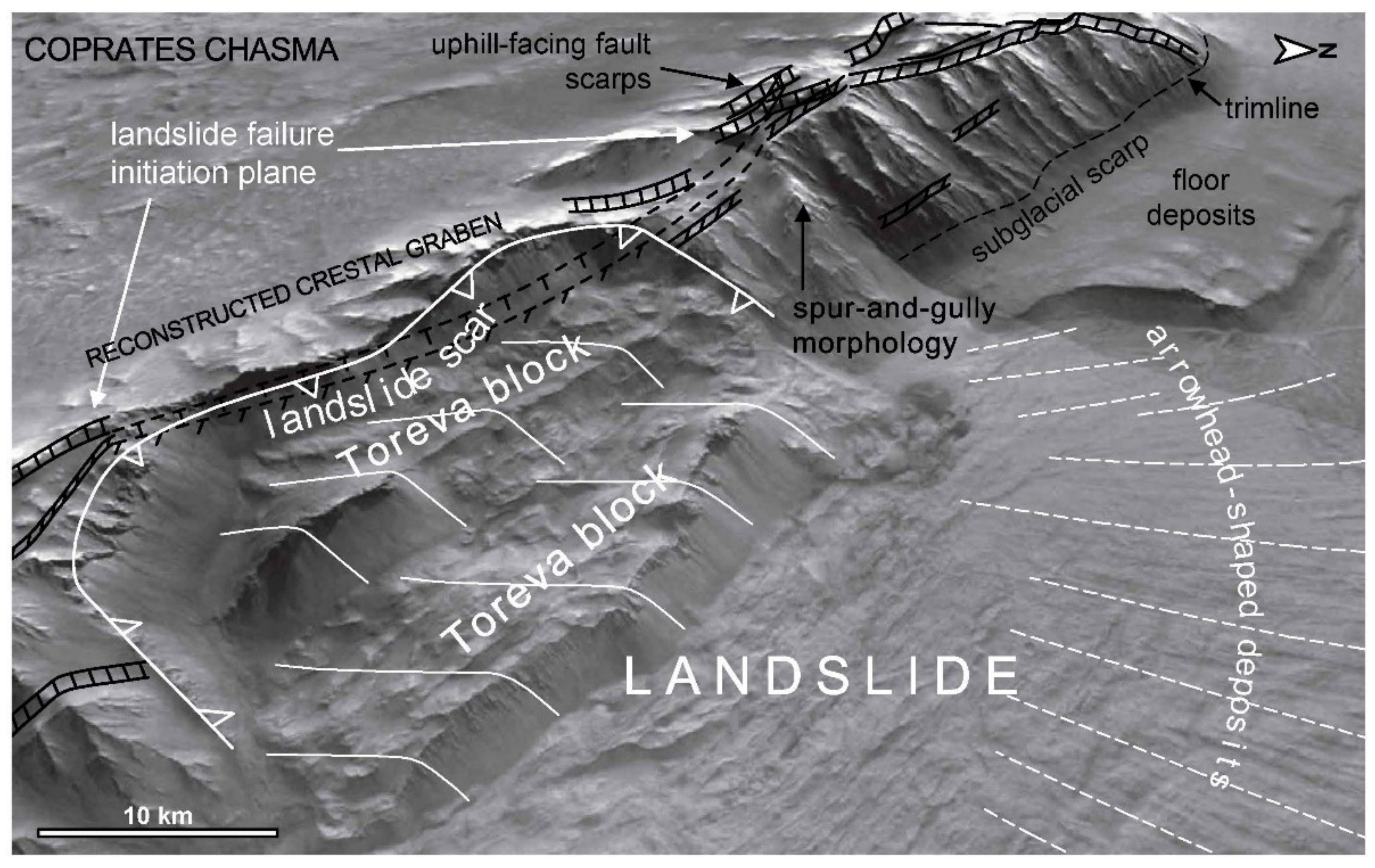
Publisher’s Note: MDPI stays neutral with regard to jurisdictional claims in published maps and institutional affiliations. |
© 2021 by the authors. Licensee MDPI, Basel, Switzerland. This article is an open access article distributed under the terms and conditions of the Creative Commons Attribution (CC BY) license (https://creativecommons.org/licenses/by/4.0/).
Share and Cite
Discenza, M.E.; Esposito, C.; Komatsu, G.; Miccadei, E. Large-Scale and Deep-Seated Gravitational Slope Deformations on Mars: A Review. Geosciences 2021, 11, 174. https://doi.org/10.3390/geosciences11040174
Discenza ME, Esposito C, Komatsu G, Miccadei E. Large-Scale and Deep-Seated Gravitational Slope Deformations on Mars: A Review. Geosciences. 2021; 11(4):174. https://doi.org/10.3390/geosciences11040174
Chicago/Turabian StyleDiscenza, Marco Emanuele, Carlo Esposito, Goro Komatsu, and Enrico Miccadei. 2021. "Large-Scale and Deep-Seated Gravitational Slope Deformations on Mars: A Review" Geosciences 11, no. 4: 174. https://doi.org/10.3390/geosciences11040174
APA StyleDiscenza, M. E., Esposito, C., Komatsu, G., & Miccadei, E. (2021). Large-Scale and Deep-Seated Gravitational Slope Deformations on Mars: A Review. Geosciences, 11(4), 174. https://doi.org/10.3390/geosciences11040174






